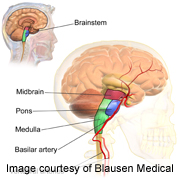
WEDNESDAY, July 31 (HealthDay News) — The hot flashes that bedevil many women going through menopause appear to originate in specific brain areas, scientists say.
“We think we have the beginnings of what is happening in the brain,” said researcher Vaibhav Diwadkar, associate professor of psychiatry and behavioral neurosciences at Wayne State University in Detroit.
“Activity in certain areas of the brain changes even before the hot flash occurs,” Diwadkar said.
The findings, published in the June issue of Cerebral Cortex, may eventually give experts an idea of how well a menopause treatment is working, beyond a woman’s self-reports. “In the future, we can measure the effects of treatment by measuring brain activity,” he explained.
Menopause — the end of a woman’s monthly periods — can involve unpleasant symptoms, including disrupted sleep, flagging energy and hot flashes, which are intense temporary episodes of warmth caused by hormonal changes.
For the study, Diwadkar and his colleagues asked 20 healthy, menopausal women, aged 47 to 58, who had six or more hot flashes a day to undergo a special type of MRI known as a functional MRI. The women remained in the machine for about two hours, in between two body-sized heating pads, waiting for a hot flash.
The researchers identified the flashes by collecting levels of skin conductance, an electrical measure of sweating.
The investigators found that activity in the brainstem preceded the hot flashes. The brainstem connects the hemispheres of the cerebellum with the spinal cord. Its sub-regions are involved in thermal regulation.
Activity in the insula — in the front of the brain — followed the hot flash. This area, part of the cerebral cortex, has been linked with the personal perception of how you feel.
The researchers were surprised to find activity in the brain even before the hot flash, Diwadkar said, but they were not surprised at the neural origins of the hot flashes, which they always suspected. “It’s not as if we went looking for an elephant and found a unicorn,” he said. With hot flashes, “there has to be something going on in the brain,” he added.
The findings are helpful, said Robin McAllen, a professor at the University of Melbourne in Australia, who was not involved in the study.
“For the first time, it separates the early brain events,” McAllen said. But more work is needed, including finding the neural pathways that trigger the hot flash, he noted.
“This is a clear advance from our previous state of knowledge (which was not great),” McAllen added. “It points the way forward, but we are still a long way from being able to use this work to find new treatments for hot flashes.”
Among the treatments used to relieve hot flashes are hormone therapy or antidepressants. Dressing in layers, so that jackets or sweaters can be removed when a hot flash occurs, is often recommended.
Dietary changes might also help some women bothered by hot flashes. Triggers are said to include hot and spicy foods, caffeinated beverages, alcohol and smoking.
More information
To learn more about menopause, visit the U.S. Office on Women’s Health.
Copyright © 2025 HealthDay. All rights reserved.

